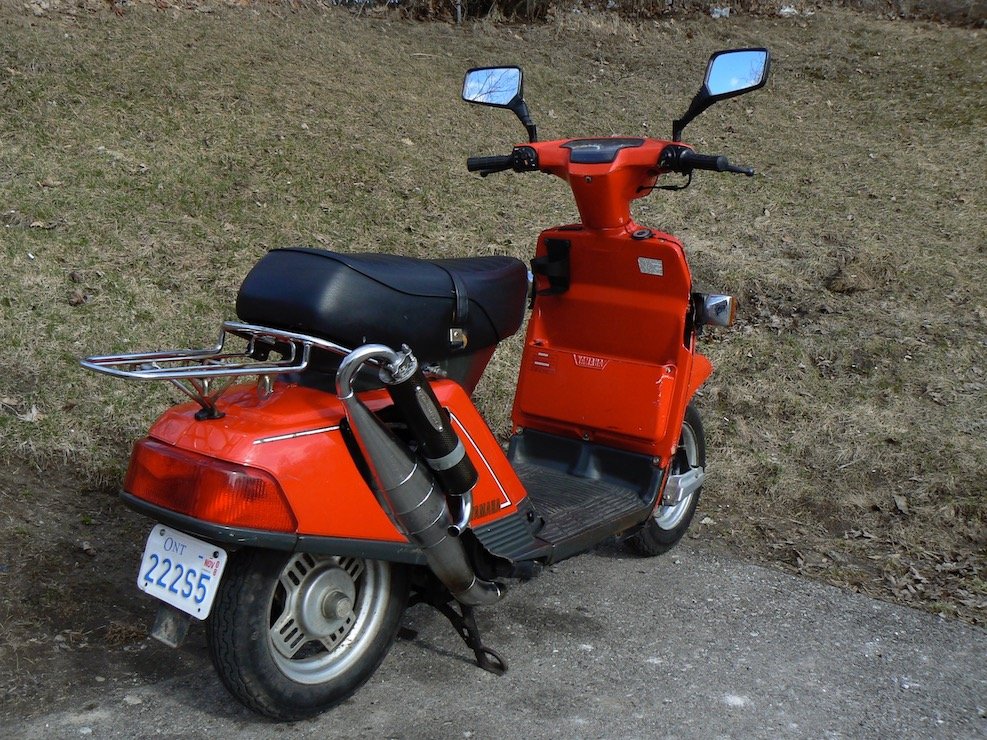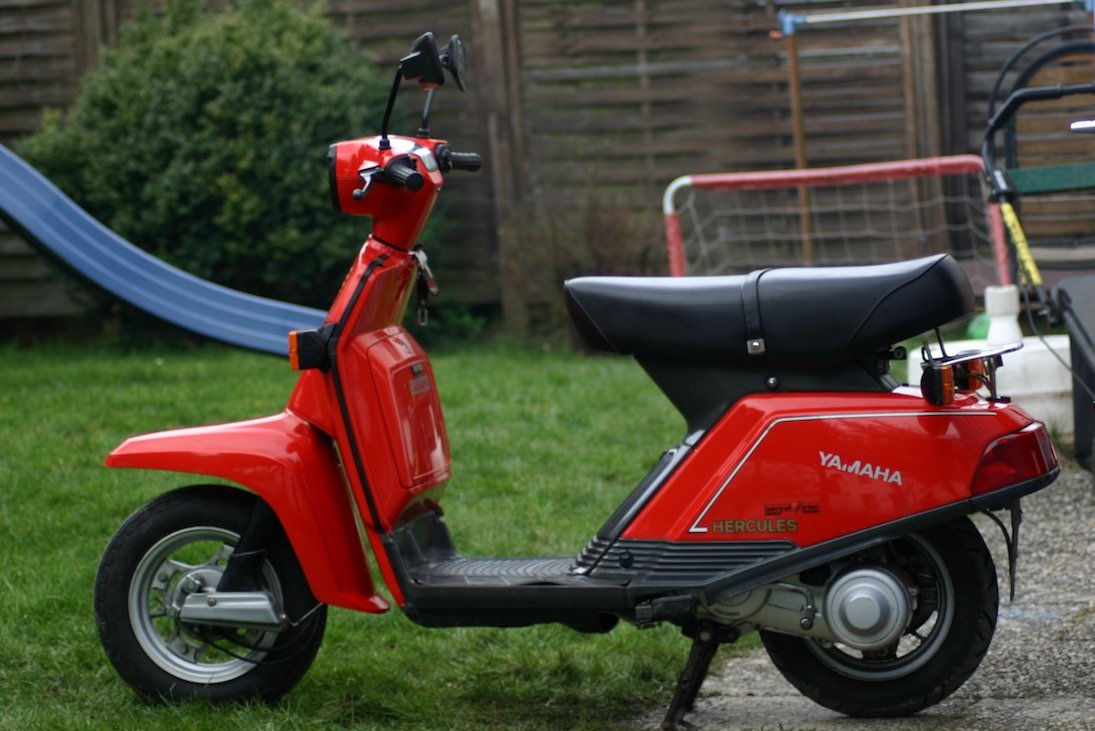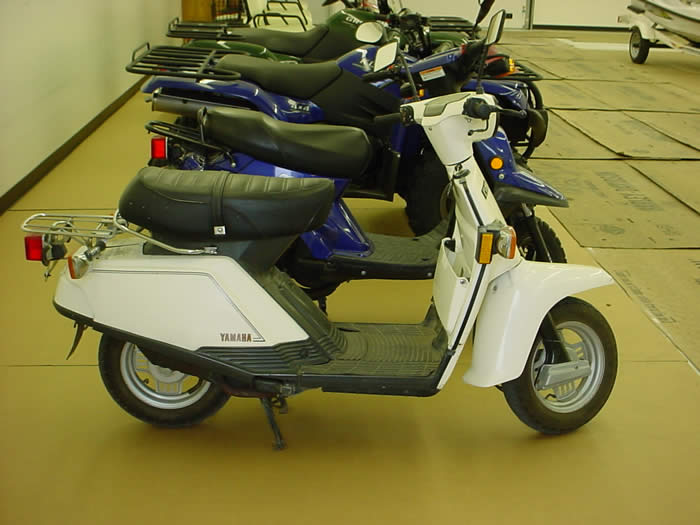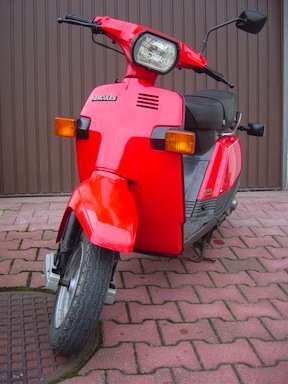YAMAHA RIVA 80 / BELUGA (CV80)
The Yamaha CV80 was an 80cc 2-stroke scooter that was produced from 1981 to 1987 and was sold all over the world. For sure, it was sold in Canada, USA, Holland, Belgium, Sweden and Japan. The CV80 was sold under several names worldwide including “Beluga” (Japan, Canada, Europe), Riva 80 (USA), CV80 (USA and elsewhere) and City CV 80 (Europe). It was also sold in Europe under the Hercules badge instead of Yamaha.
The CV80 was sold in Canada from ’82 – ’87 and in the USA from ’83 – ’87. With its 1982 introduction in Canada, the Beluga (and it’s 50cc Salient sibling) became the first modern Japanese scooters to be sold in North America.
Motor
The Riva 80 was powered by an air cooled, 80cc 2-stroke engine that featured a number of innovations that are now commonplace amongst modern scooters. These innovations were electric start, auto-choke, oil injection (2-stroke) and the CVT transmission.
For the first few years, the CV80 was extremely slow for an 80cc, slower than even a modern 50cc 4-stroke. It’s contemporaries (Honda Aero 80 and Vespa PX80) produced considerably more power. Early CV80’s (pre ’85) top out at an okay 36 mph but it takes forever to get there. Honda’s competing Aero 80 is truthfully faster across the board while carrying a driver and passenger, than the CV80 is with just a driver. Racing an Aero 80 (or probably any scooter) on a stock ’81-’83 CV80 is a humbling lesson. The main reasons for the CV80’s anemic performance are the restrictive exhaust system, tiny carburetor and tall gearing that doesn’t let this engine rev. It seems that Yamaha went overboard when they tried to make this scooter docile and friendly.
Part way through the CV80’s model life, it seems Yamaha realized they had overly restricted this scooter, so they made a number of revisions that dramatically improved the performance. Yamaha changed the 13mm carb to a 16mm carb, replaced the exhaust with sort of an expansion chambered design and they introduced a new cylinder, head, variator, reed cage and intake manifold (and more). These revisions were implemented at different times in different countries. Europeans seem to have gotten these changes for the 1983 model year, while USA customers didn’t get them until the ’85 model year. In Canada, it seems that Yamaha implemented these changes gradually over a few years (’84-’85).
The performance difference between the early and late versions of the CV80 is quite dramatic. The early model CV80 is rated at 4.7hp, whereas the revised model produces 6.9hp. Accordingly, the late model CV80 has considerably better acceleration and tops out around 75km/hr instead of 60km/hr. A European magazine compared these versions and recorded 0-60km/hr times of 15.8 seconds (early model) compared to 10.5 seconds for the revised version. Anyone who’s in the market for a CV80 should try to hold out for one of the improved models from the later years. These later CV80’s also have a side stand which is a nice touch. The side stand is not easily retrofittable as it requires a mount welded to the frame.
For any owners seeking to make their CV80 faster, there are fairly easy ways to improve the performance including retrofitting the improved parts, tossing in lighter rollers and installing aftermarket exhausts and bigger carbs. Speeds of 50-60mph are attainable fairly easily. For more on this read:
http://cv80.phpbbweb.com/viewtopic.php?t=5&mforum=cv80
Electrical System
The electrical system is another weak point of the CV80. The electrical system is rated at a mere 48 watts of 6 volt power at max output (which occurs at the redline). When you consider that the headlight is 25 watts, the dash lighting is 15 watts and the taillight is 5 watts, that means you’re using up 45 watts just riding along. So if you apply the brakes (25 watts), use the horn or flick on the blinkers (17 watts x 2), your demand is dramatically exceeding the available supply. The result is borderline dangerous. If you’re riding a curvy road at night and you hit the brakes for a corner, the headlight dims so dramatically that you’re left almost in the dark. Even worse is slowing down for a turn where you apply the brakes and flick the blinkers on. The headlight virtually goes out when the blinker blinks.
Another problem is that the electric start almost never works because the electrical system typically doesn’t provide enough juice to charge the battery and the whole system is pretty much too weak even when charged to start a cold engine. CV80 riders normally use the kick-starter for everything and then the electric start is a backup tool in case your scooter ever stalls in traffic. With such discretionary e-start usage and a warmed up engine, you may get it started.
Style
The CV80 was initially intended for the Japanese market and thus was designed to meet only Japanese safety rules. Accordingly, when Yamaha decided to sell this model in Europe and North America, they needed to make changes to the blinkers and/or taillight. With the exception of Sweden, the integrated front and rear blinkers (not shown) did not meet regulations in the rest of the world, so Yamaha opted to externalize the rear blinkers and widen the front blinkers with an ugly plastic appendage. The original JDM integrated front blinkers are still available from Yamaha Japan (as of 2011) for about $40 each.
For more on this read:
http://cv80.phpbbweb.com/viewtopic.php?p=820&mforum=cv80#820
Fortunately for European owners, the integrated rear taillight (pictured below) was apparently okay to sell there, but North American owners got stuck with a cheap external taillight as well. Owners of North American CV80’s can retrofit the flushmounted taillight (and internal blinkers) if they can source one from Europe or Japan. Here is a guide on the process:
http://cv80.phpbbweb.com/viewtopic.php?t=47&mforum=cv80
Any North American owner who retrofits this taillight (and any European owner) can activate the internal blinkers following this guide:
http://cv80.phpbbweb.com/viewtopic.php?t=52&mforum=cv80
In addition to these safety changes, Yamaha also deprived North American owners by giving them a hapless gear slot instead of the nice lockable and large glovebox (shown above) provided in the rest of the world. The gear slot North American’s received is virtually useless, due to its small size and it’s fondness for cracking and breaking, but you might fit a slim baguette in there. You can retrofit the glovebox if you can find yourself a European or Japanese one but finding one isn’t easy. You’d likely need to get a European acquaintance to find a used CV80 and strip these parts for you.
 Accessories & Aftermarket Parts
Accessories & Aftermarket Parts
Unfortunately, no aftermarket parts are available for the CV80 but Yamaha did initially sell a number of nice accessories. Yamaha sold a weird rack to hold a tennis racket (in Japan) and a windscreen and storage box (worldwide). The storage box is particularly nice as it matches the Beluga’s style very well and it provides a nice increase in lockable storage. Generally these accessories are quite rare, but with diligence on eBay or Craigslist they can be found. Browse Craigslist until you see a CV80 for sale with the accessory you want, and then contact the seller and offer a generous amount if they sell the accessory separately.
In terms of aftermarket parts no one makes aftermarket parts specifically for the CV80, so you’re stuck using universal parts or finding parts from other applications. For more info on what’s out there, check out this link:
http://cv80.phpbbweb.com/viewtopic.php?t=5&mforum=cv80
As a former owner of a CV80, this scooter holds a soft spot in my heart but it’s still hard to recommend this scooter over a comparable Honda. Compared to Honda’s Aero 80, the CV80 is significantly slower, gets worse milage, lacks decent storage and has a poor electrical system. The CV80 may very well be the last vehicle sold in North America to use a 6 volt electrical system. Motorcycles converted to 12 volts in the 60’s. The main draw of the Riva 80 is its styling, which is more classic than the modern scooters to come.
So far this writeup has been awfully negative but the CV80 doesn’t deserve that. The CV80 is a charming scooter that delights with its intangibles. It is fun to ride and it’s got a pretty unique and quirky (in a fun way) look. It’s unfortunate Yamaha opted to remove the glovebox for the North American market because some real storage space would be a big con removed from the list. If you’re interested in buying a CV80 because you love how it looks or because you found a great deal, just get one of the later models. The milage is substandard for a scooter but it still beats any car. The electrical system is annoying but if you keep that in mind you’ll be okay. The lack of storage, well that sucks but you can always wear a knapsack.
Pros:
- Quirky vintage look
- Unique and significant scooter, it’s Yamaha’s first modern scooter
- Sketchy suspension makes it a blast to ride
Cons:
- Quirky vintage look
- Fuel mileage (120km/5L or 60mpg) for the early models, even worse for the newer ones
- Very slow (early models) or slow (later models)
- 6 volt electrical system
- Virtually no useable storage space (the storage slot hardly fits anything)
Links:
Riva 80 Ad & Brochure Scans – A look back at the early 80’s literature from the USA and elsewhere
CV80 Riders Forum – A forum specifically for CV80’s. Check it out for the library of old info
MotorscooterGuide Forums – Visit the forum on this site to chat about this scoot.
Half a Step Ahead – An excellent book packed with info and stories about restoring a CV80
RivaRiders – Yahoo group of Riva owners.
SpeedandSport.com – Good for finding NOS parts to get your CV80 up and running.
Key Specs:
- Engine: Air cooled, 2-stroke single with auto choke and oil injection
- Starter: Electric and Kick
- Horsepower: 4.7hp (early model) & 6.9hp (updated model) both at 6000 RPM.
- Torque: 4.8 lbs-ft (early model)
- Redline: 8000 RPM
- Bore x Stroke: 49mm x 42mm
- Compression Ratio: 6.8:1
- Idle Speed: 1500 +/- 50 RPM
- Sparkplug: NGK BP6HS (early model) or NGK B8HS (revised version)
- Fuel Tank Capacity: 4.7 Litres
- Tire PSI: 14 psi (front) and 22 psi (rear) or 36 psi (rear with passenger)
- Dry Weight: 89kg (original version) or 92kg (updated version).
- Electrical System: 6 Volt
- Magneto Output: 48 watts
- Battery: 6N11-2D
- Seat Height: 29.7”
- Dry weight: 187lbs
- Wheelbase: 47.2”
- Fuel Tank: 1.2gal (4.7 litres)
- Mileage: 94mpg (Yamaha’s spec), 60mpg realistically
- Oil Tank: 1.2 quarts, 1.1 litres
- Colors: Chappy Red, Clean White, Crystal Silver
- MSRP: $899 (1984 USA)
The author’s 55mph CV80 modified with a custom pipe, euro tail light, larger carb, different cylinder etc.




 Accessories & Aftermarket Parts
Accessories & Aftermarket Parts